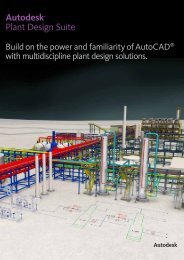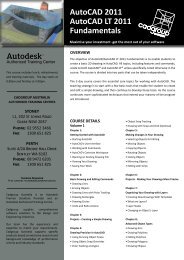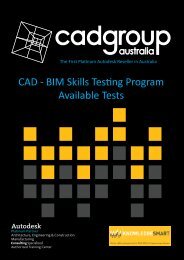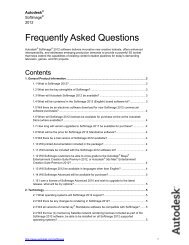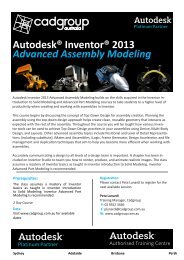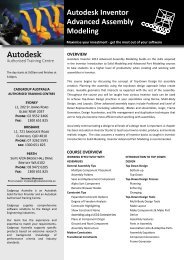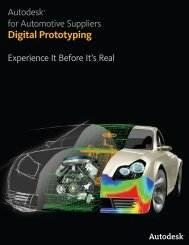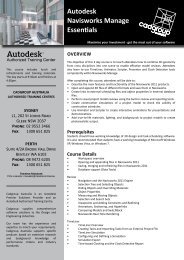Return on Investment White Paper - Cadgroup
Return on Investment White Paper - Cadgroup
Return on Investment White Paper - Cadgroup
- No tags were found...
You also want an ePaper? Increase the reach of your titles
YUMPU automatically turns print PDFs into web optimized ePapers that Google loves.
ROI with Autodesk RevitThe denominator, which is the “investment” or “cost” part of the equati<strong>on</strong>, includes the costof the system (A) and the cost of the productivity lost, in terms of labor cost, as the userlearns how to use the system. This sec<strong>on</strong>d term is the product of the m<strong>on</strong>thly labor cost (B)multiplied by m<strong>on</strong>ths in training time (C) multiplied by productivity lost in training (D),therefore B x C x D. Throughout this paper “training time” refers not to the length of atraining course, but to the time it takes a user to reach the same level of productivityexperienced <strong>on</strong> the original system.The numerator represents the “earnings” part of the equati<strong>on</strong> and those earnings comefrom an increase in human productivity. The increase in average m<strong>on</strong>thly productivity isrepresented in the left bracket ((B - (B / 1 + E). The right bracket (12 – C) is the number ofm<strong>on</strong>ths in a year (12) minus m<strong>on</strong>ths in training (C). If the user needs three m<strong>on</strong>ths tobecome as productive <strong>on</strong> the new system as <strong>on</strong> the old, then there are nine m<strong>on</strong>ths left inthe year to benefit from the productivity gains.As an example of how productivity affects ROI, imagine the user is not more productiveafter training than before (E = 0). E equals zero. The entire left bracket would then be zeroedout, resulting in a first year ROI of zero. On the other hand, if the user doubles hisproductivity after training (E = 1), than labor cost is cut in half ((B – B/2), and the ROIwould be 100 percent. Productivity has a profound effect <strong>on</strong> ROI.Some Real NumbersFormulas are impressive but make more sense with real numbers. The numbers below willbe used for the purposes of this white paper, but you can substitute your own in the ROIcalculator provided at the end.A = cost of hardware and software $6,000B = m<strong>on</strong>thly labor cost $4,200C = training time3 m<strong>on</strong>thsD = productivity loss during training 50%E = productivity gain after training 25%Following is an explanati<strong>on</strong> of how each of the numbers was derived. Several came fromdata collected in a December 2003 Autodesk survey of Revit users (approximately 100 usersprovided resp<strong>on</strong>ses to a survey invitati<strong>on</strong> posted <strong>on</strong>line).Cost of hardware and software (A) — A Revit system (hardware and software) sells foraround $6,000. This cost does not include training or support. It is simply a base system forthe purposes of working the ROI formula.M<strong>on</strong>thly labor cost (B) — In the design world there are several terms to describe laborcosts. Direct Labor Cost is the hourly wage of an employee. Direct Pers<strong>on</strong>nel Expense (DPE)is the hourly wage plus another 30-40 percent to account for benefits and other employeespecificoverhead. The billing rate is the Direct Labor Cost or the DPE marked up by a factor(often between two and three) to cover a company’s overhead and profit margin. Becausemost project managers focus <strong>on</strong> DPE in their budgets as the managed cost, it makes senseto use this term for the ROI formula.www.autodesk.com/revit 3



